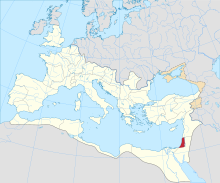
Back Iudaea (Romeinse provinsie) Afrikaans يهودا (مقاطعة رومانية) Arabic Іўдзея (рымская правінцыя) Byelorussian Юдея (римска провинция) Bulgarian রোমীয় যিহূদিয়া প্রদেশ Bengali/Bangla Proviñs Judea Breton Judea romana Catalan Judea Czech Iudaea Welsh Iudaea Danish
| Province of Judaea | |||||||||
|---|---|---|---|---|---|---|---|---|---|
| Province of the Roman Empire | |||||||||
| 6 CE–132 CE | |||||||||
 The Roman Empire under the reign of Hadrian (125 CE) with Judaea highlighted in red | |||||||||
| Capital | Caesarea Maritima | ||||||||
| Area | |||||||||
| • Coordinates | 32°30′N 34°54′E / 32.500°N 34.900°E | ||||||||
| Government | |||||||||
| Prefects before 41, Procurators after 44 CE | |||||||||
• 6–9 CE | Coponius | ||||||||
• 26–36 CE | Pontius Pilate | ||||||||
• 64–66 CE | Gessius Florus | ||||||||
• 117 CE | Lusius Quietus | ||||||||
• 130–132 CE | Tineius Rufus | ||||||||
| King of the Jews | |||||||||
• 41–44 CE | Agrippa I | ||||||||
• 48–93/100 | Agrippa II | ||||||||
| Legislature | Synedrion/Sanhedrin | ||||||||
| Historical era | Roman Principate | ||||||||
• Annexation to the Roman Empire | 6 CE | ||||||||
| c. 30/33 CE | |||||||||
• Crisis under Caligula | 37–41 CE | ||||||||
| 44 CE | |||||||||
| 70 CE | |||||||||
• Assigned a governor of praetorian rank and given the 10th Legion | c. 74 CE | ||||||||
• Merging into Syria Palaestina | 132 CE 132 CE | ||||||||
| |||||||||
| Today part of | Israel Palestine | ||||||||
| Before 4 August 70 is referred to as Second Temple Judaism, from which the Tannaim and Early Christianity emerged. | |||||||||
Judaea[1] was a Roman province from 6 to 132 CE, which at its height incorporated the Levantine regions of Judea, Idumea, Samaria, and Galilee, and parts of the costal plain including Philistia, extending over the territories of the Hasmonean and Herodian kingdoms. The name Judaea (like the similar Judea) was derived from the Iron Age Kingdom of Judah, that was centered predominantly in Judea.
Since the Roman Republic's conquest of Judea in 63 BCE, the latter had maintained a system of semi-autonomous vassalage. The incorporation of the Roman province was enacted by the first Roman emperor, Augustus, after an appeal by the populace against the ill rule of Herod Archelaus (4 BCE – 6 CE).
With the onset of direct rule, the official census instituted by Publius Sulpicius Quirinius, the governor of Roman Syria, caused tensions and led to an uprising by Jewish rebel Judas of Galilee (6 CE). Other notable events in the region include the crucifixion of Jesus c. 30–33 CE (which led to the emergence of Christianity) and in 37 CE, Emperor Caligula ordered the erection of a statue of himself in the Second temple.
Growing discontent at Roman rule led to the First Jewish–Roman War in 66–73 CE and ultimately the Siege of Jerusalem and destruction of the temple in 70 CE,[2] bringing an end to the Second Temple period. In 44 CE, Galilee and Perea were added to the province.[citation needed] In 132 CE, the merging of Galilee and Judea resulted in an enlarged province named Syria Palaestina.[3][4][5]
- ^ (Latin: Iudaea [juːˈdae̯.a]; Ancient Greek: Ἰουδαία, romanized: Ioudaía [i.uˈdɛ.a])
- ^ Westwood, Ursula (1 April 2017). "A History of the Jewish War, AD 66–74". Journal of Jewish Studies. 68 (1): 189–193. doi:10.18647/3311/jjs-2017. ISSN 0022-2097.
- ^ Clouser, Gordon (2011). Jesus, Joshua, Yeshua of Nazareth Revised and Expanded. iUniverse. ISBN 978-1-4620-6121-1.
- ^ Spolsky, Bernard (27 March 2014). The Languages of the Jews: A Sociolinguistic History. Cambridge University Press. ISBN 978-1-107-05544-5.
- ^ Brand, Chad; Mitchell, Eric; Staff, Holman Reference Editorial (2015). Holman Illustrated Bible Dictionary. B&H Publishing Group. ISBN 978-0-8054-9935-3.